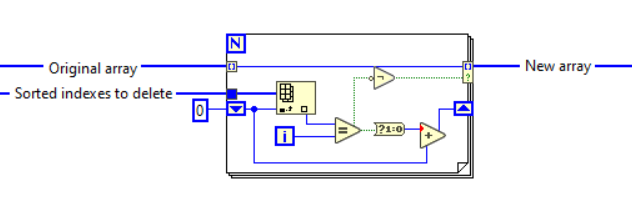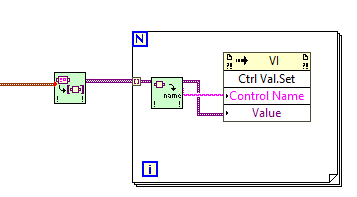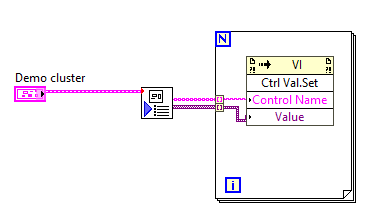-
Posts
468 -
Joined
-
Last visited
-
Days Won
33
Content Type
Profiles
Forums
Downloads
Gallery
Everything posted by Mads
-
You beat us well @ShaunR 🙂 Normally I would use replace in situations like this too, to get the advantage of the preallocated memory. I improved some of the OpenG array functions that exact way (which is now included in Hooovah's version), but lately I've gotten so used to the performance and simplicity of conditional indexing that I did not grab for it here 🤦♂️.
-
A bit quicker it seems is to use conditional indexing, like this: On my machine I got the following results (turned off debugging to avoid it interfering with test and removed the display of input as I would occationally get memory full errors with it): Original: 492 ms ensegre original: 95 ms ensegre with multiply by 3 instead of 3 adds: 85 ms Conditional indexing: 72 ms There might be even better ways..The efficiency of conditional indexing is often hard to beat though. demo_rev1.vi
-
On a related note GDevCon 4 just ended in Glasgow with a record number of attendees....👍 (Maybe that is partly because the alternatives are not as good/many anymore, but let me be optimistic for a while...) If Emerson does not want to kill or starve LabVIEW, maybe there is a nice future beyond 10 years as well. Retirement age is steadily getting pushed upwards though so personally it would be nice if things went on for another 25 years, or even better; allowed our kids to make a career working with G everywhere in 2050😀
-

Where do y'all get your (free) artwork for UI elements?
Mads replied to David Boyd's topic in User Interface
We use the nuvola icon set for a lot of things. -
The link only points to Jordan's profile, but he might have been involved back then yes...
-
I had noted a simple recipe earlier from here somewhere for manually installing lvzlib.so (OpenGZip 4.2beta) on Linux RT 2020 and newer now that the "Custom Install" option no longer exists / works in NI Max, but I seem to have lost it and cannot find it again. Do anyone know where that discussion was, or has the recipe?
-
When it comes to "Remove Duplicates" the performance of OpenG is a bit of a curious case (unless I am just overlooking something obvious). The original OpenG function builds the output arrays one element at a time, but still (in my LabVIEW 2022 at least) outperforms the alternatives I make where I reuse the input array. The latter use less memory it seems, as expected, but it is as if LabVIEW has become smarter when there are repeated build operations (but not for the functions we have gone through previously...(yes debugging is disabled..) 🤨 The attached version is a simplified one of the original suggested revision. As mentioned it does seem to use less memory than the original OpenG, but is still slower 😞 Remove duplicates.zip
-
Not sorting the array we are processing, sorting the array of elements to delete. That is done just to facilitate the filtering algorithm, it does not affect the array that is to be processed. (Unless the sort has somehow gotten misplaced somewhere in the code that has been bounced around here...)
-
Performance mainly becomes an issue when the task at hand is heavy. I do not think saving microseconds on a small array/filter list is worth losing milliseconds or seconds when the array gets large. So that would be the rationale for simply ignoring the "quick on small arrays, slow on large" and choosing the one that is the fastest in the worst cases. However - there is one case where this can become an argument *for* keeping the other algorithms too; namely when you have to repeatedly run through small array/filtering jobs....🤨 Life is never easy😬 The "Revised version" is the best middle ground; quicker than all on most small and medium arrays, and still 2x times quicker than OpenG on worst case scenarios. The Rev2 one is 10 times quicker then...but in truly worst case scenarios you typically end up writing customized algorithms instead of using generic libraries anyway...(I would then often skip the deleted array indexes output to get things even quicker e.g.).
-
An inversion error snuck in, if you look at the code and invert the inversion its right 🙂 Attached here... Filter 1D test - fixed.zip
-
The old read me file says that only 8 functions were changed so I took a look at one of them now: Filter 1D array Improvement when filtering every 5th element in a 100k array: 2.4x Improvement when filtering every 100th element: 2.2x Improvement when filtering every 1000th element: 1.8x OK, but not that impressive... However, looking at the algorithm I saw that there are repeated 1D Array searches for the whole array of elements to filter, that is costly. So I threw in a new alternative where that search is based on the sorted search instead. That makes a big difference when the number of items to filter is big, for the test cases above the results on my computer were Improvement when filtering every 5th element in a 100k array: 227x Improvement when filtering every 100th element: 22x Improvement when filtering every 1000th element: 3x Now the last algorithm changed two things, it uses both conditional indexing and sort/search sorted array. The sorting bit could just as well be added to the original revision...I guess the reason why OpenG still does not use conditional indexing is to be backwards compatible (very far now though...), and then the in-built sorted search would not be available either. That could be replaced by a binary search function that was available back then too though. Filter 1D test.zip
-
Looks good @hooovahh, feel free to use it / the inspiration 🙂 in your VIMs. PS. Twelve years ago (!) I made other optimized implementations of many of the OpenG functions and posted them here. I could not find them though, but I attached it here now. I am sure some of them are not that much quicker anymore / have better alternative implementations now, but some of them probably are better. I have not gone through them again yet. 1509324986_OpenGArrayRevisedR4LV2011.zip
-
You cannot. The costly method (more so the larger the array and the number of deletes are) is to do repeated deletes (decrementing delete indexes as you go if you do it in order e.g., see attached example code). It is costly in both memory and speed due to reallocation on every round. (The same goes for array building; do not do it one element/subarray at a time, pre-allocate the full size then replace (or use auto-indexing in for loop to have LabVIEW pre-allocate automatically)). For multiple deletes nowadays I suspect conditional array indexing will most often be the most (or at least quite) efficient way to handle it. Something like this (NOTE this particular example assumes sorted (and non-empty) delete indexes!): If the evaluation of which elements to delete can be done within the loop the logic gets simpler... Doing a quick test on my computer, comparing it with deletes of half the elements in an array of 100k elements (extreme case), this cuts the time of the operation from a whopping 3 seconds to 0,4 ms (OpenG does multiple deletes from the end instead of start, that is only marginally better (1,5 sec) than deletes from the start (3 sec), as you can see in the example code). Before effective conditional indexing in for-loops was added to LabVIEW a more efficient algorithm (still, but only very slightly) would involve shifting array elements (using replace, which is very fast and does not allocate) we want to keep to the front, then taking the subarray with the new size in one operation. I have added that to the attached example. Methods of deleting multiple array elements.vi
-

Including solicitation of interest from potential acquirers
Mads replied to gleichman's topic in LAVA Lounge
Perhaps it would be better if Elon bought NI and shifted the focus back to "the software is the instrument (and the car, and the rocket...and everywhere)"😀 Bringing the electric car from tiny boring cars to where it is today is a journey the G-language deserves as well. -
@Jordan Kuehn, have you been able to get this listed as an option in the software install list, or did you use another channel to get the package onto the device? I assumed you could add a ldirectory of ipk files as a local feed, and that that would allow you to see it as an option in the software install menu of the RT image, but I could not get that to work...If you did, how did you do that? I tried adding a local folder as a feed...but the package did not show up in the list of available software. And if this is the way we are supposed to go, is there a way to make one package with support for both arm and x64 e.g., or would you always need separate ipk files?
-
You are trying to avoid a soft reboot as well I assume, not just a power cycle..(which would not be necessary anyway). You can issue a killall lvrt command through the ssl interface and it will restart the application, so if you replace the executable then do that you migth suceed (have not tried), here are two related threads: https://forums.ni.com/t5/NI-Linux-Real-Time-Discussions/quick-software-restart/td-p/3407711 https://forums.ni.com/t5/Real-Time-Measurement-and/Running-a-Real-Time-executable-from-inside-the-CRIO/td-p/3570063
- 1 reply
-
- rtlinux
- startup.rtexe
-
(and 3 more)
Tagged with:
-
I think that is the point he is trying to make though (based on the title of the thread); that LabVIEW should let us specify which plot we are working on when setting a property without it being overruled by what is done elsewhere as long as that is not actually on the same plot. If e.g. you have one location where you want to set the property of plot 2 and you also have some code in parallel working on a a property of plot 4 they should be able to declare/access the separate plots *without the risk of a race condition*. I agree with @infinitenothing, it is a bad design (I have not checked if anyone has already asked for a change of that in the idea exchange though. It would be a good idea to post there.)
-
In our commercial software such dialogs and event logs never expose anything in other than an understandable description of what did not go as planned, and if possible a suggestion on what to do to fix it (the code will evaluate events at key locations and produce user friendly interpretations). The only thing included in the dialog that has to do with the underlying code is the error code specified as a sub-code of a more user friendly overall code (which is what they can also see described in the user manual) and source that tells what the software was trying to do. When support gets involved we have other means to dig out the underlying details (task specific event logging, debug-windows etc.).
-
A related discussion on this is available on the JSONtext Issues page, here: https://bitbucket.org/drjdpowell/jsontext/issues/7/what-should-null-mean-when-extracting-data
-

Bundling Values from ini file into complex Cluster
Mads replied to rareresident's topic in LabVIEW General
One option, perhaps not as flexible as you want but still: OpenG Configuration file VIs can read the ini-file and convert it to clusters, which could then be converted to json using e.g. @drjdpowell's JSONtext... To get up and running with a more flexible solution (i.e. without the need for defined clusters) you could probably pick and merge parts from those two libraries. -
I ended up getting too frustrated (again) with the stupidity of having clusters in the GUI involved in key navigation and locked to one terminal . so all controls are individual/primitives in the GUI again. Then the challenge however is that initializing all those individual controls is an inflexible and space-eating affair when done in the traditional graphical way (unbundling extra large clusters). So: How to programmatically fetch all values from a huge cluster and initialize all equivalent individual controls in the GUI? Well, one way I had been using before was to use a Ctrl Val.Set property. That works fine as long as the names of the individual controls in the cluster(s) are unique and match the labels of the controls in the GUI....but you then have to "flatten" the cluster to a list of names and variants. If the cluster(s) do not contain subclusters I use this OpenG-based method: But in this case the cluster is complex - and there are sub-clusters within subclusters, something this code does not handle. The OpenG configuration VIs handle this in "Write INI cluster", but not in a way directly translatable to a list of names and variants as the recursive algorithm to access sub clusters does not translate into this use case.... So I wrote the attached VIs to flatten any complex cluster into its individual element names and variants: The initialization code could alternatively be put into the VI itself instead, and perhaps a blacklist/only init these input could be added, but for now this does the job: It keeps the initialization code very compact and flexible - even though the cluster(s) in question is complex and might change later (sorry, did not rewrite it to JSON instead...not yet at least @drjdpowell😳) Is anyone else doing something similar, perhaps better? Demo of cluster to init of individual controls.zip
-
I wouldn't want this. User management is difficult to develop, maintain, and keep secure. It would be unwise for NI to roll their own manager; they should integrate existing, tried-and-true technologies. Currently, non-Enterprise SystemLink does use LDAP and Windows Active Directory for user management, which is good. I haven't looked closely at what new technologies are available under Enterprise (Jordan mentioned OAuth?) We do not want to roll our own, so we want SystemLink to handle it. And if NI does not want to roll their own - they can always use subcomponents that does, but to us as a user of SystemLink it would/should appear to be handled by SystemLink😉. In our case the bulk of the users would be external clients and we would not want to handle their dashboard accounts in Active Directory...typically the user management would be handled by support engineers that would not have admin-access to AD. I see some of these issues mentioned in the latest release note though. Perhaps it is time to have a closer look again.
-
The presentation seems to show that we need to implement custom user account handling...(helpful in that regard, although just browsing quickly through the video it does not seem to be a particularly secure method - sending user names and passwords(perhaps I overlooked an underlying encryption?). What we were hoping for, as far as I remember now, was that that the user account administration and logon was handled securely by SystemLink itself, and that the selection of dashboards and/or what data those had access to would then depend on the user account (then only the last part might require the G-code to know anything about the user).







